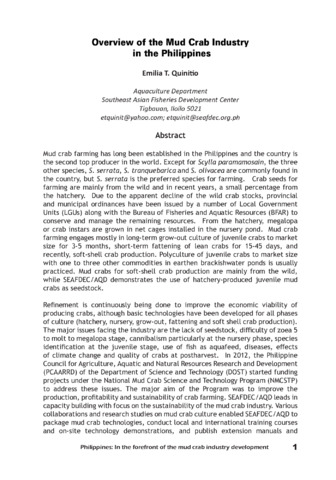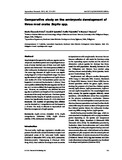Evaluation of hatchery-based enhancement of the mud crab, Scylla spp., fisheries in mangroves: comparison of species and release strategies
| dc.contributor.author | Lebata, Ma. Junemie Hazel L. | |
| dc.contributor.author | Le Vay, Lewis | |
| dc.contributor.author | Walton, Mark E. | |
| dc.contributor.author | Biñas, Joseph B. | |
| dc.contributor.author | Quinitio, Emilia T. | |
| dc.contributor.author | Rodriguez, Eduard M. | |
| dc.contributor.author | Primavera, Jurgenne | |
| dc.date.accessioned | 2014-05-27T01:13:09Z | |
| dc.date.available | 2014-05-27T01:13:09Z | |
| dc.date.issued | 2009 | |
| dc.identifier.citation | Lebata, M. J. H. L., Le Vay, L., Walton, M. E., Biñas, J. B., Quinitio, E. T., Rodriguez, E. M., & Primavera, J. H. (2009). Evaluation of hatchery-based enhancement of the mud crab, Scylla spp., fisheries in mangroves: comparison of species and release strategies. Marine and Freshwater Research, 60(1), 58-69. | en |
| dc.identifier.issn | 1323-1650 | |
| dc.identifier.uri | http://hdl.handle.net/10862/2095 | |
| dc.description.abstract | Ranching, stock enhancement and restocking are management approaches involving the release of wild or hatchery-bred organisms to enhance, conserve or restore fisheries. The present study, conducted from April 2002 to November 2005, evaluated the effectiveness of releasing wild and hatchery-reared (HR) mud crabs in the mangroves of Ibajay, Aklan, Philippines where preliminary studies demonstrated declining fishery yields, abundance and size of crabs. Comparison of survival and growth of wild-released and HR Scylla olivacea and HR Scylla serrata demonstrated the effect of nursery conditioning, size-at-release and species differences. Overall yield and catch per unit effort (CPUE) increased by 46% after stock enhancement trials. Recapture rates of released crabs were highest in wild-released S. olivacea and in crabs measuring 65.0–69.9 mm carapace width (CW) and lowest in non-conditioned HR S. serrata. Growth rates were highest for conditioned HR S. olivacea and lowest for conditioned HR S. serrata (11.7 and 3.7 mm month-1 respectively). Fishing mortality was highest for S. olivacea, whereas natural mortality was greater for S. serrata. Conditioning hatchery-bred animals before release is also important in obtaining higher survival. S. olivacea was the more appropriate of the two species for release in mangrove habitats inundated with low-salinity water. However, there is a need for site-specific studies to evaluate the effectiveness of releases. | en |
| dc.language.iso | en | en |
| dc.publisher | CSIRO Publishing | en |
| dc.subject | Decapoda | en |
| dc.subject | Scylla | en |
| dc.subject | Scylla serrata | en |
| dc.subject | Scylla olivacea | en |
| dc.title | Evaluation of hatchery-based enhancement of the mud crab, Scylla spp., fisheries in mangroves: comparison of species and release strategies | en |
| dc.type | Article | en |
| dc.identifier.doi | 10.1071/MF08155 | |
| dc.citation.volume | 60 | |
| dc.citation.issue | 1 | |
| dc.citation.spage | 58 | |
| dc.citation.epage | 69 | |
| dc.citation.journalTitle | Marine and Freshwater Research | en |
| seafdecaqd.library.callnumber | VF SJ 0831 | |
| dc.subject.asfa | hatcheries | en |
| dc.subject.asfa | growth rate | en |
| dc.subject.asfa | stocking (organisms) | en |
| dc.subject.asfa | crab fisheries | en |
| dc.subject.asfa | nursery grounds | en |
| dc.subject.asfa | depleted stocks | en |
| dc.subject.asfa | marine crustaceans | en |
| dc.subject.asfa | mangroves | en |
| dc.subject.asfa | fishing | en |
| dc.subject.asfa | mortality | en |
| dc.subject.asfa | abundance | en |
| dc.subject.asfa | fisheries | en |
| dc.subject.asfa | survival | en |
| dc.subject.asfa | habitats | en |
| dc.subject.asfa | ranching | en |
| dc.subject.asfa | mud | en |
| dc.identifier.essn | 1448-6059 | |
| dc.subject.scientificName | Scylla serrata | en |
Files in this item
| Files | ขนาด | รูป | View |
|---|---|---|---|
|
There are no files associated with this item. |
|||
รายการนี้ปรากฏใน (s)
-
Journal Articles [1256]
These papers were contributed by Department staff to various national and international journals.




